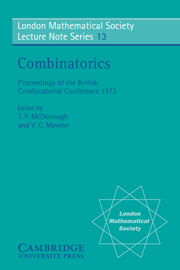Book contents
- Frontmatter
- Contents
- Preface
- Papers contributed by the participants
- Perfect codes and distance-transitive graphs
- Generalisation of Fisher's inequality to fields with more than one element
- On balanced arrays
- Positions in Room squares
- Analogues of Heawood's theorem
- Cut-set lattices of graphs
- On the chromatic index of a graph, II.
- On a theorem of R. A. Liebler
- Outerthickness and outercoarseness of graphs
- Graphs with homeomorphically irreducible spanning trees
- A note on embedding latin rectangles
- Some results in semi-stable graphs
- Hereditary properties and P-chromatic numbers
- Some problems concerning complete latin squares
- Necklace enumeration with adjacency restrictions
- On a family of planar bicritical graphs
- On the enumeration of partially ordered sets of integers
- The distance between nodes in recursive trees
- Partition relations
- On a problem of Daykin concerning intersecting families of sets
- Unstable trees
- Distance-transitive graphs
- Enumeration of graphs on a large periodic lattice
- Some polynomials associated with graphs
- Equidistant point sets
- Eigenvalues of graphs and operations
- Graph theory and algebraic topology
- Applications of polymatroids and linear programming to transversals and graphs
- Problem section
Cut-set lattices of graphs
Published online by Cambridge University Press: 05 April 2013
- Frontmatter
- Contents
- Preface
- Papers contributed by the participants
- Perfect codes and distance-transitive graphs
- Generalisation of Fisher's inequality to fields with more than one element
- On balanced arrays
- Positions in Room squares
- Analogues of Heawood's theorem
- Cut-set lattices of graphs
- On the chromatic index of a graph, II.
- On a theorem of R. A. Liebler
- Outerthickness and outercoarseness of graphs
- Graphs with homeomorphically irreducible spanning trees
- A note on embedding latin rectangles
- Some results in semi-stable graphs
- Hereditary properties and P-chromatic numbers
- Some problems concerning complete latin squares
- Necklace enumeration with adjacency restrictions
- On a family of planar bicritical graphs
- On the enumeration of partially ordered sets of integers
- The distance between nodes in recursive trees
- Partition relations
- On a problem of Daykin concerning intersecting families of sets
- Unstable trees
- Distance-transitive graphs
- Enumeration of graphs on a large periodic lattice
- Some polynomials associated with graphs
- Equidistant point sets
- Eigenvalues of graphs and operations
- Graph theory and algebraic topology
- Applications of polymatroids and linear programming to transversals and graphs
- Problem section
Summary
Let G be a connected, undirected, simple graph. Let V(G) and E(G) denote the vertex and edge sets respectively. Consider two different vertices a, b of G. A subset T of the vertex (edge) set is called an a, b-vertex (edge) cut if T separates a and b but no proper subset T' of T does, i. e. if in G - T the vertices a and b belong to different connected components but in G - T' there is always an a, b path. Cuts with the smallest cardinality are called minimal.
Let now S, T be two a, b-vertex (edge) cuts and order them in such a way that S ≦ T if and only if no a, b-path meets T ‘before’ S. Then it can be shown that ≦ is a partial order; indeed we have (for proofs see for example [1]):
Theorem 1.Let Γ1and Γ2be the sets of all a, b-vertex cuts and a, b-edge cuts, respectively, of a graph G with respect to two different, fixed vertices a, b of G. Then (Γ1, ≦) and (Γ2, ≦) constitute complete lattices.
Theorem 2.Let Δ1and Δ2be the sets of all minimal a, b-vertex cuts and minimal a, b-edge cuts, respectively, of a graph G with respect to two different, fixed vertices a, b of G. If the cardinality of the cuts is finite, then (Δ1, ≦) and (Δ2, ≦) constitiite distributive lattices.
Information
- Type
- Chapter
- Information
- Combinatorics , pp. 35 - 36Publisher: Cambridge University PressPrint publication year: 1974
